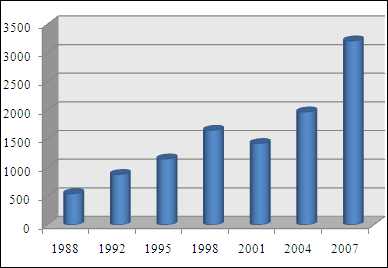The foreign exchange market (currency, forex, or FX) is where currency trading takes place. It is where banks and other official institutions facilitate the buying and selling of foreign currencies.[1]FX transactions typically involve one party purchasing a quantity of one currency in exchange for paying a quantity of another. The foreign exchange market that we see today started evolving during the 1970s when worldover countries gradually switched to floating exchange rate from their erstwhile exchange rate regime, which remained fixed as per the Bretton Woods system till 1971.
Presently, the FX market is one of the largest and most liquidfinancial markets in the world, and includes trading between large banks, central banks, currency speculators, corporations,governments, and other financial institutions. The average daily volume in the global foreign exchange and related markets is continuously growing. Traditional daily turnover was reported to be over US$3.2 trillion in April 2007 by the Bank for International Settlements.[2] Since then, the market has continued to grow. According to Euromoney's annual FX Poll, volumes grew a further 41% between 2007 and 2008.[3]
The purpose of FX market is to facilitate trade and investment. The need for a foreign exchange market arises because of the presence of multifarious international currencies such as US Dollars, Euros, Japanese yen, Pounds Sterling, etc., and the need for trading in such currencies.
The foreign exchange market is unique because of
- its trading volumes,
- the extreme liquidity of the market,
- its geographical dispersion,
- its long trading hours: 24 hours a day except on weekends (from 22:00 UTC on Sunday until 22:00 UTC Friday),
- the variety of factors that affect exchange rates.
- the low margins of profit compared with other markets of fixed income (but profits can be high due to very large trading volumes)
- the use of leverage
As such, it has been referred to as the market closest to the idealperfect competition, notwithstandingmarket manipulation by central banks. According to the Bank for International Settlements,[2]average daily turnover in global foreign exchange markets is estimated at $3.98 trillion. Trading in the world's main financial markets accounted for $3.21 trillion of this. This approximately $3.21 trillion in main foreign exchange market turnover was broken down as follows:
- $1.005 trillion in spot transactions
- $362 billion in outright forwards
- $1.714 trillion in foreign exchange swaps
- $129 billion estimated gaps in reporting
Of the $3.98 trillion daily global turnover, trading in Londonaccounted for around $1.36 trillion, or 34.1% of the total, making London by far the global center for foreign exchange. In second and third places respectively, trading in New York accounted for 16.6%, and Tokyo accounted for 6.0%.[4] In addition to "traditional" turnover, $2.1 trillion was traded in derivatives.
Exchange-traded FX futures contracts were introduced in 1972 at the Chicago Mercantile Exchange and are actively traded relative to most other futures contracts.
Several other developed countries also permit the trading of FX derivative products (like currency futures and options on currency futures) on their exchanges. All these developed countries already have fully convertible capital accounts. Most emerging countries do not permit FX derivative products on their exchanges in view of prevalent controls on the capital accounts. However, a few select emerging countries (e.g., Korea, South Africa, India—[2]; [3]) have already successfully experimented with the currency futures exchanges, despite having some controls on the capital account.
FX futures volume has grown rapidly in recent years, and accounts for about 7% of the total foreign exchange market volume, according to The Wall Street Journal Europe (5/5/06, p. 20).
| Rank | Name | Volume |
|---|---|---|
| 1 | 21.70% | |
| 2 | 15.80% | |
| 3 | 9.12% | |
| 4 | 7.49% | |
| 5 | 7.30% | |
| 6 | 4.19% | |
| 7 | 4.10% | |
| 8 | 3.58% | |
| 9 | 3.47% | |
| 10 | 2.86% |
Foreign exchange trading increased by 38% between April 2005 and April 2006 and has more than doubled since 2001. This is largely due to the growing importance of foreign exchange as an asset class and an increase in fund management assets, particularly of hedge funds and pension funds. The diverse selection of execution venues have made it easier for retail traders to trade in the foreign exchange market. In 2006, retail traders constituted over 2% of the whole FX market volumes with an average daily trade volume of over US$50-60 billion (see retail trading platforms).[6] Because foreign exchange is an OTCmarket where brokers/dealers negotiate directly with one another, there is no central exchange or clearing house. The biggest geographic trading centre is the UK, primarily London, which according to IFSL estimates has increased its share of global turnover in traditional transactions from 31.3% in April 2004 to 34.1% in April 2007. The ten most active traders account for almost 80% of trading volume, according to the 2008 Euromoney FX survey.[3] These large international banks continually provide the market with both bid (buy) and ask (sell) prices. The bid/ask spreadis the difference between the price at which a bank or market makerwill sell ("ask", or "offer") and the price at which a market-maker will buy ("bid") from a wholesale customer. This spread is minimal for actively traded pairs of currencies, usually 0–3 pips. For example, the bid/ask quote of EUR/USD might be 1.2200/1.2203 on a retail broker. Minimum trading size for most deals is usually 100,000 units of base currency, which is a standard "lot".
These spreads might not apply to retail customers at banks, which will routinely mark up the difference to say 1.2100/1.2300 for transfers, or say 1.2000/1.2400 for banknotes or travelers' checks. Spot prices at market makers vary, but on EUR/USD are usually no more than 3 pips wide (i.e., 0.0003). Competition is greatly increased with larger transactions, and pip spreads shrink on the major pairs to as little as 1 to 2 pips.




No comments:
Post a Comment